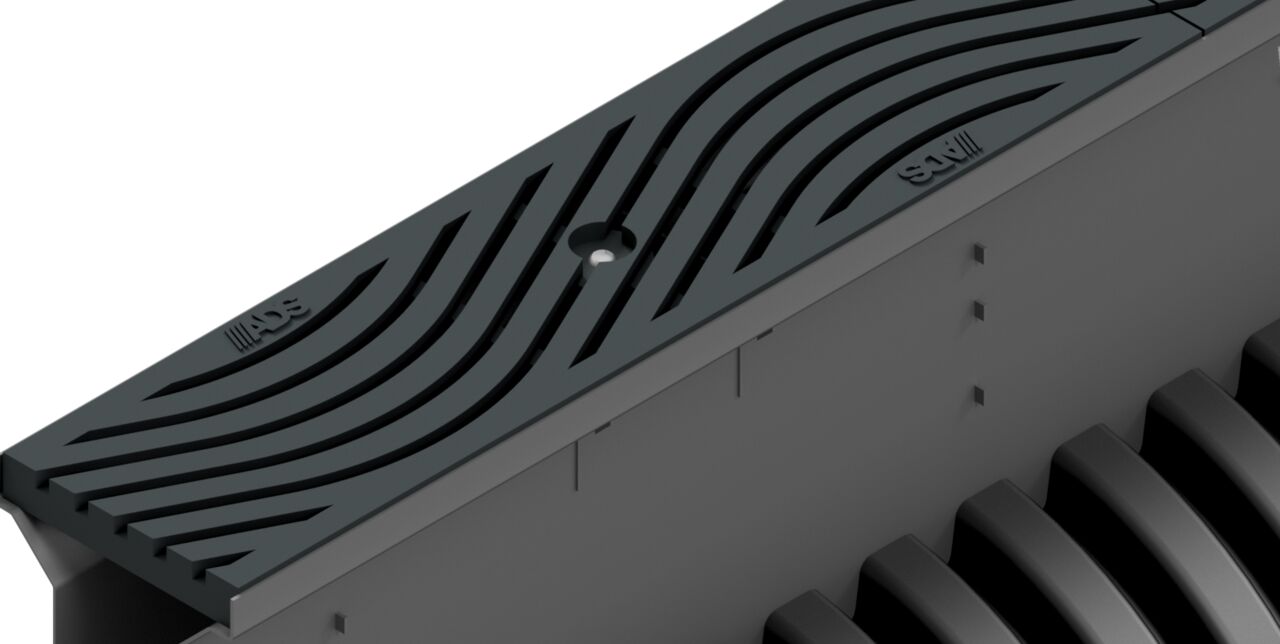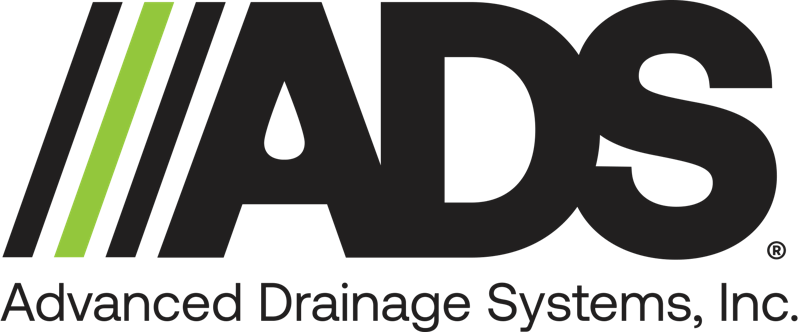Product
September 22, 2025 / 7 minute read
Designing Linear Drain Systems with ADS Duraslot and Duraslot XL

ADS’s Duraslot slotted drains and Duraslot XL trench drains are unique products that combine stormwater capture and high-volume conveyance into one system. These products eliminate the need for large grates and use round pipes to create efficient and cost effective solutions. These linear drains are excellent for creating simple yet flexible single trench designs that capture runoff and can function as a trunkline for other connections. This guide contains all the information you will need to design a linear drain system for your site.
Surface Condition
While ADS linear drains can perform many cross functions, selecting the optimal product will ensure the best results and longevity for your site. This table quickly explains the greatest benefits of each grate offered by ADS.
ADS Duraslot & Duraslot XL Grate Options (Marketing, can you help me crop?)
Capture Volume
The first step in a stormwater design is to calculate the flow rate (Q) that a system needs to handle. There are a variety of ways to do this, but a simple way is by using the Rational Method. This equation states the flow rate is a function of the surface runoff coefficient and rainfall intensity for a given area.
Rational Method Equation1
The surface runoff coefficient (C) is a dimensionless number which is a ratio of how much water is absorbed into a surface and how much will run off. The more impervious the ground, the higher the coefficient.
Common Runoff Coefficients for the Rational Method1
The intensity of rainfall (I) will be based on the climate the site is located in. Various agencies have developed intensity-duration-frequency (IDF) curves, such as the National Oceanic and Atmospheric Administration (NOAA) (link: https://hdsc.nws.noaa.gov/pfds/), and these graphs can be referenced for accurate rainfall intensity for your site. Finally, the drainage area (A) is in either acres or hectares depending on the system of measurement.
Inlet Capacity
The amount of water a grate can absorb at a given time is referred to as the inlet capacity. The capture rate and efficiency of a system is dependent on a variety of factors. The “ADS Linear Drain Inlet Capacity” (literature under development, attachment link here to the PDF) charts provide third party tested data to ensure the grate you selected will meet your site’s needs.
In most cases, conveyance capacity becomes negligible when a linear drain is over 20-feet long because the open area of the grate is so large. For instance, 15-feet of open top Duraslot slotted drain has an opening size of 315-square inches, which is roughly the same open area as a 2-foot by 2-foot grate inlet. When inlet capacity needs to be checked, there are two basic design applications.
When linear drains are installed at the lowest elevation of a given area, so that water cannot escape elsewhere, it is called a sag condition. Water will pool at the collection point and the grate will transition into an orifice condition. This produces head pressure on the grate and increases the inlet capacity. Duraslot XL trench drains are recommended over Duraslot slotted drains here, as the wider grate helps prevent surface clogging.
Sag Condition Example
The second type of installation condition is called the on grade condition. In this scenario, excess water flows over the grate and continues to a lower elevation. This application is difficult to model due to water approach velocity and grate geometry. ADS has conducted testing on one scenario you can use as a reference point for determining a possible capture rate for your design. When unsure which grate would be best, grates that are wider or have more open area will have better capture efficiency.
On Grade Condition Example
The final factor you need to consider is clogging. While ADS recommends annual maintenance on its linear drain products (maintenance guide attachment link here), it may not be frequent enough to prevent it entirely. Some agencies recommend using a clogging factor up to 50%, depending on the amount of foliage and other debris which may cover the grate. Wider grates with larger openings are less susceptible to surface clogging.
ADS’ linear drains can also be used in conjunction with Nyloplast area drains (link to the Nyloplast landing page here). Placing a basin at the outlet end can increase capture rates and provide a natural cleanout location. This also creates a smooth transition point to connect the linear drain to the rest of the storm drainage system.
Example Duraslot XL & Nyloplast Assembly
Conveyance Capacity
Once the water drops through the grate, the channel needs to be sized correctly to ensure water is moved out of the linear drain system and prevent backup. The amount of water a channel can move downstream is called the conveyance capacity. Unlike most linear drains that use open channels, ADS linear drains use round pipes from 4-inch to 36-inch in diameter which is easy to design with and allows for more efficient flow rates. Please be aware that the conveyance capacity may be higher than the inlet capacity if the system is also handling upstream flow or roof drain connections from Inserta Tees (link to Inserta Tee landing page). In some cases, you may want to oversize your system to cut down on maintenance intervals.
Example Duraslot & Inserta Tee Assembly
Unlike most other linear drains, Duraslot & Duraslot XL can be designed with a custom pipe slope to meet the exact needs of your site. “Figure 3-1, Discharge Rates for ADS Corrugated Pipe with Smooth Interior Liner” (attachment link here to the PDF) from the ADS “Drainage Handbook” (attachment link here) can be used to select the correct pipe size. On this nomograph, two variables (i.e. pipe slope and flow rate) can be used to discover the missing value (i.e. pipe size). Duraslot and Duraslot XL connect readily to ADS’ N12 HDPE pipe and some sizes of HP Storm pipe. This seamless connection eliminates the necessity of outlet structures and provides a smooth transition to the rest of the storm drainage system.
Example Duraslot & Outlet Tee Example
The industry recommends a minimum 0.5% pipe slope as it significantly improves conveyance rates and offers some self-cleaning compared to a neutral slope design. A 2% pipe slope is generally considered self-cleaning, but may not be practical on longer runs due to the rapid increase in slot height exceeding manufacturing tolerances. Finally, the difference between the grade slope and the pipe slope cannot exceed 4%. For instance, if the grade slope is 1.6% in one direction, the greatest pipe slope in the opposite direction would be 2.4%.
Other Resources
Another thing to keep in mind is the burial depths of the product, especially as a run of linear drain gets longer or slopes get steeper. On the second page of “TN 2.11 Duraslot and Duraslot XL Burial Depths and Backfill Conditions” (attachment link here to the PDF), there are a couple of easy to use tables that detail out the minimum and maximum burial depths for these products. This is also a good resource if you are looking to learn more about backfill design.
If designing specifically for road and highway conditions, a well-established method for designing open top slotted drain is available in the Federal Highway Administration’s “Hydraulic Engineering Circular No. 22 (HEC-22), Urban Design Manual” (link: https://www.fhwa.dot.gov/Engineering/hydraulics/library_arc.cfm?pub_number=22&id=189) and provides a more granular approach that may be preferred for this specific product and application. ADS has developed a simple design tool to automate these equations (link to the tool attached here).
Linear drains are normally installed in straight runs, but they can be installed with bends or in a radius under certain conditions. The “Duraslot & Duraslot XL Radius Design Guide” (attachment link here to the PDF) provides a quick overview of how to use these products in this application.
